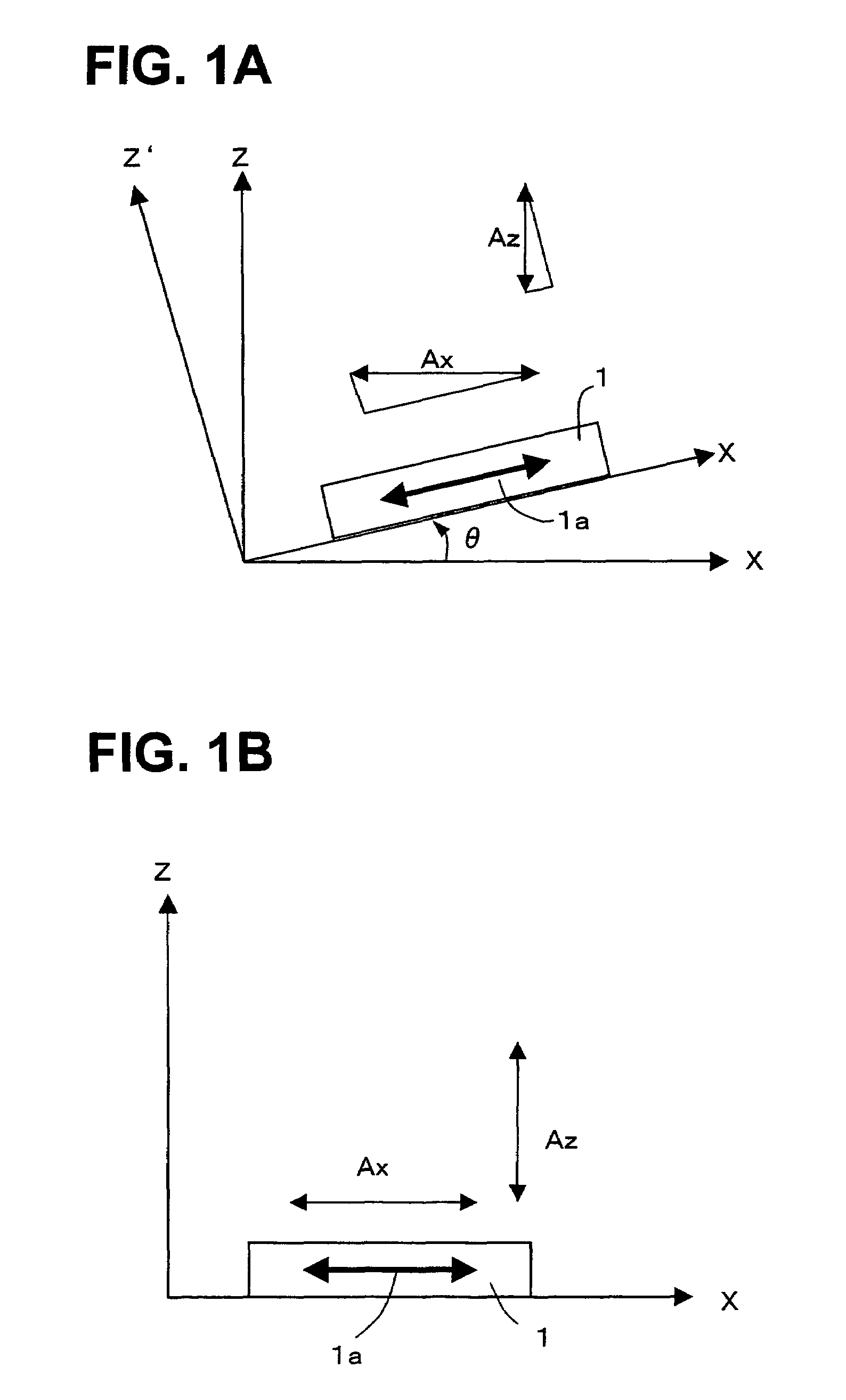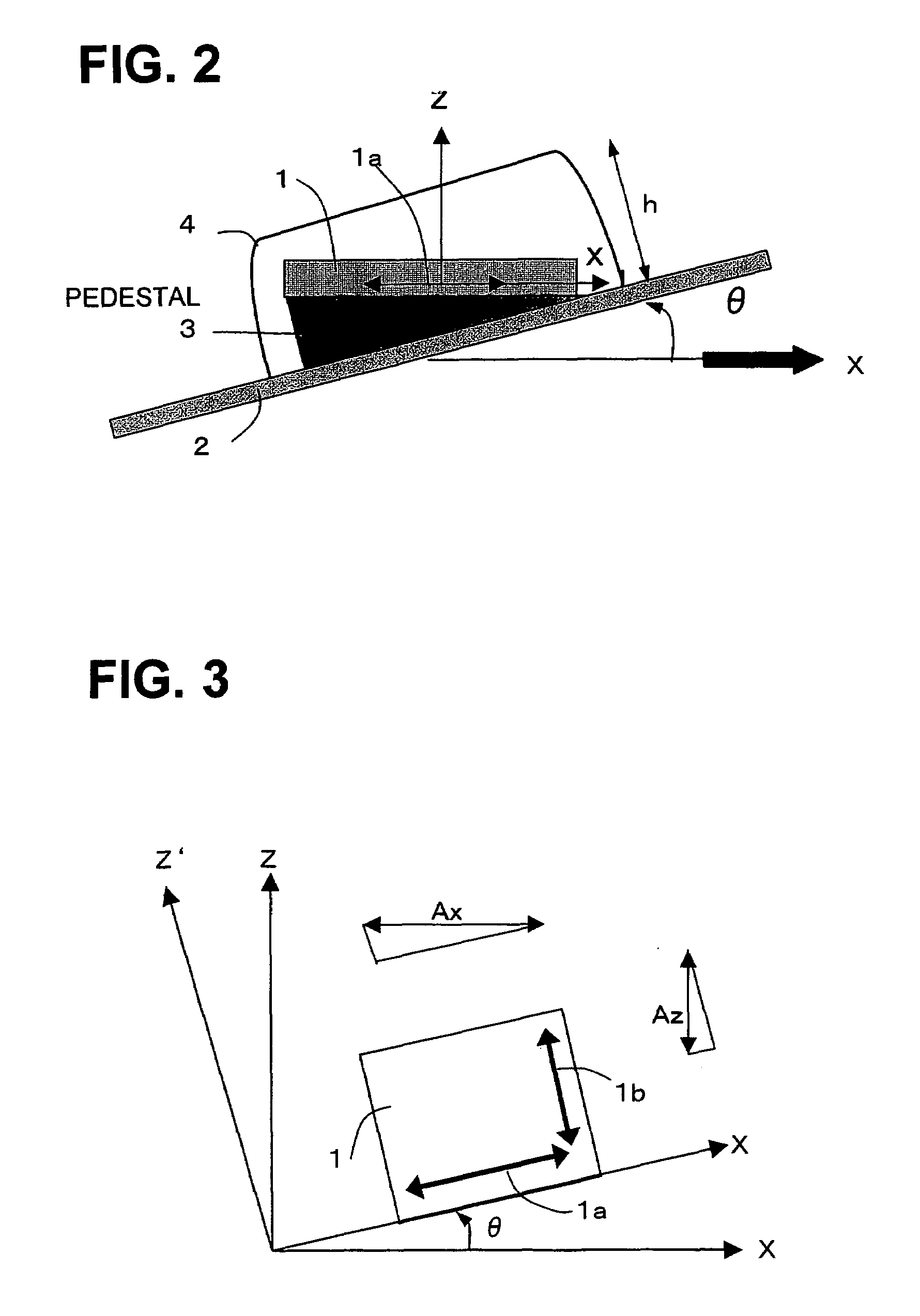Stress detection method for sensor device with multiple axis sensor and sensor device employing this method
a sensor device and multiple axis technology, applied in the direction of force/torque/work measurement apparatus, instruments, calibration apparatus, etc., can solve the problems of navigation device mounting, unnecessary braking or unstable state, spin judgment,
- Summary
- Abstract
- Description
- Claims
- Application Information
AI Technical Summary
Benefits of technology
Problems solved by technology
Method used
Image
Examples
first embodiment
[0069]FIG. 3 illustrates the operating principles of the first embodiment of the present invention.
[0070]In the conventional example shown in FIG. 1, a force sensor that has only one detection axis is used in order to detect the stress in the detected axis direction of the object. In contrast, in the first embodiment according to the present invention, a 2-axis detection output is used.
[0071]As an embodiment example, in the example shown in FIG. 3, a 2-axis detection output, namely of an axis in a horizontal direction (X-axis) and an axis in a vertical direction (Z axis), is used.
[0072]That is, as shown in FIG. 3, the force sensor 1 has force sensors 1a and 1b for sensing stress components corresponding with the X-axis and Z-axis directions respectively. In a case where the force sensor 1 is mounted tilted by θ with respect to the detected axis X of the object, the stress component Apx sensed by the force sensor 1a and the stress component Apz sensed by the force-sensor 1b are produ...
second embodiment
[0083]FIGS. 5A to 5C illustrate the operating principles of the second embodiment of the present invention. This embodiment detects the stress on the detected axis by using three force sensors.
[0084]FIG. 5A illustrates the stress component of the x and y axes, which are two axes in mutually opposite directions by angle Φ from the detected axis X when stress F1 is provided on the detected axis X (or Y axis, described as the X axis hereinbelow). Two force sensors a and b for detecting the stress component along the x and y axes are provided.
[0085]Stress components Fx1 and Fy1, which are detected by force sensors a and b respectively, are as follows.
Fx1=αx×F1×cos Φ
Fy1=αy×F1×cos Φ
[0086]The sensor further comprises a force sensor c, which senses the stress in the Z-axis direction as a third force sensor. FIG. 5B illustrates the stress detection of the force sensor c.
[0087]Gravity (F2) acts on the force sensor c as stress in the Z-axis direction. Therefore, the stress component Fz1, which...
embodiment example 1
[0117]FIG. 6 is an explanatory view of an embodiment example in which the force sensor device to which the present invention is applied is constituted by a multiple-axis resistor-type force sensor chip.
[0118]FIG. 6A is a top view of a fabricated sensor chip that is mounted in a package 10 of the force sensor device. FIG. 6B is a cross-sectional view along the line A-A′.
[0119]As the fabrication step, piezoresistive elements 14 and A1 wiring are first formed on the surface of an SOI substrate that is obtained by bonding the Si substrate 100, on which a thermal oxide film SiO2 101 is formed, to a second Si substrate 102 by means of anodic coupling as shown in FIG. 6A. FIG. 6A shows only the piezoresistors 14.
[0120]Next, region 16 is etched by subjecting the second Si layer 102 to Deep RIE or the like. In addition, etching is performed from the side of the first Si substrate 100. At this time, because the oxide film layer (SiO2) 101 prevents etching of the second Si layer 102, region 16...
PUM
| Property | Measurement | Unit |
|---|---|---|
| angle | aaaaa | aaaaa |
| stress | aaaaa | aaaaa |
| stress | aaaaa | aaaaa |
Abstract
Description
Claims
Application Information
 Login to View More
Login to View More - R&D
- Intellectual Property
- Life Sciences
- Materials
- Tech Scout
- Unparalleled Data Quality
- Higher Quality Content
- 60% Fewer Hallucinations
Browse by: Latest US Patents, China's latest patents, Technical Efficacy Thesaurus, Application Domain, Technology Topic, Popular Technical Reports.
© 2025 PatSnap. All rights reserved.Legal|Privacy policy|Modern Slavery Act Transparency Statement|Sitemap|About US| Contact US: help@patsnap.com



